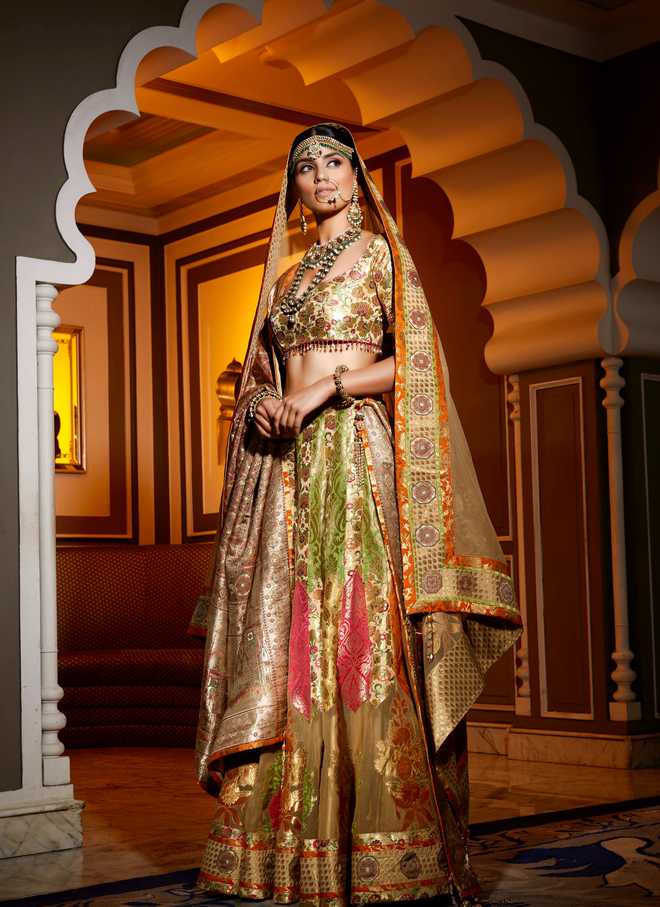Swati Rai
Aesthetics in a culturally rich India have often evolved to suit the sartorial definition of different times. Hence, Western, Asian and Persian influences are reflected in our architecture, ornaments and garments. For that matter, even embroidery techniques, treatment of the fabric, patterns and stitching methods have been experimented upon. Thus, the trends we witness today are a permutation and combination of erstwhile styles. Whoever said fashion is cyclical was so right.
One such point in time that continues to inspire designers is the Mughal era. Farshi salwar, zardozi, salma sitaras… all find expression in the current designer landscape. Ace couturier JJ Valaya swears by Mughal-inspired motifs. “When spices were traded through the Silk Route, influences on food and attire too came along,” says Valaya who finds Oriental and Eastern world motifs and designs more inspiring than the Western counterparts. Manish Malhotra too showcased his collection The Persian Story, inspired from the embroidery patterns of Persia at the India Couture Week.
Most embroidery forms found their origin in the Mughal era. Chikan is traditional embroidery from Lucknow. When translated into English, the word means embroidery itself. Fashion designer Leena of Ashima-Leena duo says, “Mughal period’s luxurious, elaborate patterns create magic on the fabric. Each time I work with the embroidery, I experiment with a new pattern.”
Several other innovations like kairi and embroidery stitches in Chikankari, especially jaali and phanda stitches are inspired by the Mughal-era techniques. Even a lot of silhouettes came into being in the same time period. The ever-green Anarkali was introduced by the Mughals. So was the ubiquitous churidaar or the royal peshwaj — an outer diaphanous garment worn over the main outfit inside by Mughal women.
Cinema also contributed towards the popularity of the silhouettes. A sherwani wasn’t meant for groom until Bollywood glamourised it. Then fashion designers took it upon themselves to present silhouettes and embroideries from the Mughal era in a modern form. They ably tossed traditional aesthetics with modern treatment. They are moving towards a blend of traditional and modern design aesthetics. “Our 2016 couture collection, Mehr-un-nissa, is a perfect example of an amalgamation of traditional designs and modern twist,” adds Leena.
Talking of the research one has to do for creating an authentic piece, Ankur Modi of AM:PM says, “You need to know the history of embroidery and fabric before beginning to use it.” Zivar, their recent collection is inspired from bidri, an ancient metal handicraft that originated in Persia and flourished in the 14th century under the Bahmani empire. “We’ve incorporated many elements from this craft, like the extensive use of silver and signature artwork, along with the use of its basic colour black,” adds Priyanka Modi.
A challenge while using centuries-old patterns is how to retain the original flavour, yet make it appealing to the present generation. “While you let the artwork stay as it is, you can experiment with the silhouette. For example, a short velvet jacket with bidri can work for any formal occasion.”
For Valaya, anything that revives art should be welcomed. “Purists tend to get stuck in a time warp. You contemporise an ancient craft and if it can be used in interiors, arts, photography and fashion designing, your purpose is served,” he says. These trends from Mughal era have proved to be timeless. These are classics and thus every fashion week, you see a garara, a sharara, an Anarkali… Only the treatment differs.
Unlock Exclusive Insights with The Tribune Premium
Take your experience further with Premium access.
Thought-provoking Opinions, Expert Analysis, In-depth Insights and other Member Only Benefits
Already a Member? Sign In Now










